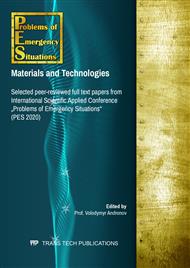[1]
E. I. Stenina, Yu. B. Levinsky, Protection of wood and wooden structures: Textbook. - Yekaterinburg: Ural State Technical University (Ural State Forestry University), (2007) 219.
Google Scholar
[2]
V. A. Voytovich, Protection of wood from burning, J. StroyPROFIL, 2 (48), (2006).
Google Scholar
[3]
E. Danilova, Burn or not burn, The Chemical Journal, July-August (2007) 49-52.
Google Scholar
[4]
M. M. Almenbaev et al., Investigation of the fire-retardant effectiveness of paints and varnishes with wood flame retardants, materials of the 21st international scientific and technical conference Security Systems-2012,, M.: Academy of GPS of the Ministry of Emergencies of Russia, (2012) 115-118.
Google Scholar
[5]
T. Mariappan, Fire Retardant Coating, In Book: New Technologies in Protective coatings, (2017).
Google Scholar
[6]
Y. Otrosh, et al., Methodology remaining lifetime determination of the building structures, MATEC Web of Conferences, 230, (2018) 02023.
DOI: 10.1051/matecconf/201823002023
Google Scholar
[7]
Advances in Fire Retardant Materials, Woodhead Publishing in Materials, Edited by A. R. Horrocks and D. Price, Cambridge, England, (2008) 599.
Google Scholar
[8]
A. A. Chernukha, et al., Fire protection of wood using gel-forming compounds based on silicates, Kharkiv, National University of Civil Defence of Ukraine, (2015), 114.
Google Scholar
[9]
V.S. Osipchik, et al., Influence of the composition of the redox system on the thermo-oxidative degradation of intercalated graphites, International Polymer Science and Technology, 38 (1) (2011) 53-56.
DOI: 10.1177/0307174x1103800111
Google Scholar
[10]
M. Sukhanevich and S. Guzii, The Effect of Technological Factors on Properties of Alkali Aluminosilicate Systems Used for Preparation of Fireproof Coatings, Refractories and Industrial Ceramics, 45 (2004) 217–219.
DOI: 10.1023/b:refr.0000036733.85631.f1
Google Scholar
[11]
P. Krivenko, Y. Pushkareva, M. Sukhanevich and S. Guziy, Fireproof coatings on the basis of alkaline aluminum silicate systems, Ceramic Engineering and Science Proceedings, 29(10) (2009) 129-142.
DOI: 10.1002/9780470456200.ch13
Google Scholar
[12]
P. Krivenko, S. Guzii and A. Kravchenko, Protection of timber from combustion and burning using alkaline aluminosilicate-based coatings, Advanced Materials Research, 688, (2013) 3-9.
DOI: 10.4028/www.scientific.net/amr.688.3
Google Scholar
[13]
A. Kravchenko and S. Guzii, Determining the fire resistance properties of timber, protected by geocement-based coatings, Eastern-European J. of Enterprise Tech., 1(5) (2015) 38-41.
DOI: 10.15587/1729-4061.2015.36843
Google Scholar
[14]
J. Tsapko, S. Guzii, M. Remenets, A. Kravchenko and A. Tsapko, Evaluation of effectiveness of wood fire protection upon exposure to flame of magnesium, Eastern-European J. of Enterprise Tech., 4(10-82) (2016) 31-36.
DOI: 10.15587/1729-4061.2016.73543
Google Scholar
[15]
K. Sotiriadis, S. Guzii, I. Kumpová, P. Mácová and A. Viani, The effect of firing temperature on the composition and microstructure of a geocement-based binder of sodium water-glass, SSP, 267 (2017) 58-62.
DOI: 10.4028/www.scientific.net/ssp.267.58
Google Scholar
[16]
Y. Tsapko, V. Kyrycyok, A. Tsapko, O. Bondarenko and S. Guzii, Increase of fire resistance of coating wood with adding mineral fillers, MATEC Web of Conferences, 230 (2018).
DOI: 10.1051/matecconf/201823002034
Google Scholar
[17]
P. Kryvenko, V. Kyrychok and S. Guzii, Influence of the ratio of oxides and temperature on the structure formation of alkaline hydro-aluminosilicates, Eastern-European J. of Enterprise Tech., Vol. 5(5-83) (2016), 40-48.
DOI: 10.15587/1729-4061.2016.79605
Google Scholar
[18]
P.V. Krivenko, S. G. Guzii, O. P. Bondarenko, Alkaline Aluminosilicate Binder-Based Adhesives with Increased Fire Resistance for Structural Timber Elements, KEM, 808 (2019) 172–176.
DOI: 10.4028/www.scientific.net/kem.808.172
Google Scholar
[19]
V. Petránek, S. Guziy, K. Sotiriadis and L. Nevřivová, Study on the properties of geocement based thermal insulating materials for high temperature technical appliances, Advanced Materials Research, 734-737 (2013) 2356-2359.
DOI: 10.4028/www.scientific.net/amr.734-737.2356
Google Scholar
[20]
Yu. Tsapko, et al., Design of fire-resistant heat- and soundproofing wood wool panels, Eastern-European J. of Enterprise Tech., 3 3/10(99) (2019), 24-31.
DOI: 10.15587/1729-4061.2019.166375
Google Scholar
[21]
K. Sotiriadis, et al., Thermal Behavior of an Intumescent Alkaline Aluminosilicate Composite Material for Fire Protection of Structural Elements, J. Mater. Civ. Eng., 31(6) (2019) 04019058.
DOI: 10.1061/(asce)mt.1943-5533.0002702
Google Scholar
[22]
S. Guzii, P. Krivenko, O. Bondarenko, T. Kopylova, Study on physico-mechanical properties of the modified alkaline aluminosilicate adhesive-bonded timber elements, SSP, 296 (2019), 112-117.
DOI: 10.4028/www.scientific.net/ssp.296.112
Google Scholar


